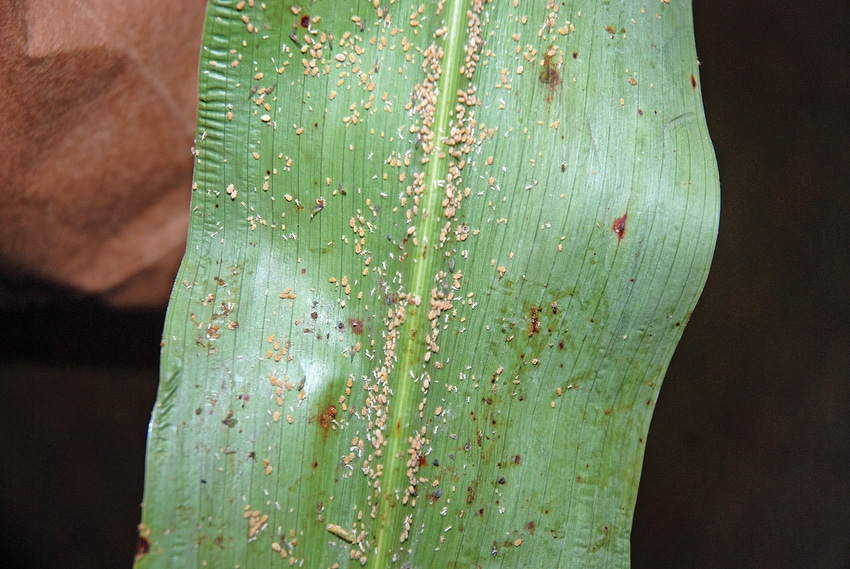
White sugarcane aphids are on the move in Mid-South grain sorghum and are making a sticky mess in some fields, according to Extension entomologists.
The aphid (Melanaphis sacchari) has been found this season in Louisiana, Texas, Oklahoma, Mississippi and Arkansas.
LSU AgCenter entomologist David Kerns said aphids have been a sugarcane pest in Louisiana since 1999, but in 2013 moved to grain sorghum for the first time. The 2013 infestation occurred late in the season and only caused harvest efficiency problems. The aphids produce a sticky honeydew that can clog harvesters.
Stay current on what’s happening in Mid-South agriculture: Subscribe to Delta Farm Press Daily.
This year, the pest arrived earlier and in higher numbers, according to Kerns. “We’re seeing more acres affected. These aphids are being found throughout the whole state now.”
Kerns says the infestations, which began in the southern part of the state and moved north, can be fairly severe and cause yield loss. “You’ll see desiccation of the heavily infested leaves. We’re seeing thousands and thousands of aphids per leaf. If you walk in and out of an infested field, your pants are just covered with aphids.”
For the most part, producers are keeping the aphids under control, according to Kerns. “But it doesn’t take long for them to build up. You have to watch them closely. I’ve been in fields with a heavy infestation here or there, but within five days the field is inundated.”
Louisiana, Mississippi and Arkansas have been granted emergency Section 18 registrations for the use of Transform on white sugarcane aphids. Kerns said Transform provides 90 percent control, which is much better than other insecticides that have only 50 percent to 60 percent control. One application of Transform is usually enough for the entire season, he said.
Kerns is seeing some reduction in control when Transform is tank-mixed with a pyrethroid for midge control.
“When the pest was confined to the south, most of the applications of Transform were going out at boot. However, as the pest has moved north, the applications are going out as sorghum is blooming.
“A lot of farmers have been piggybacking their Transform application with a pyrethroid to pick up any midge out there. We don’t know exactly what the problem is, but where we see Transform mixed with a pyrethroid, we are seeing our performance drop off. So now we are recommending that producers not mix Transform with a pyrethroid.”
When midge are present, Kerns advises adding Lorsban or generic to Transform. “It’s not as good as a pyrethroid, so if you have a really heavy midge infestation, you’ll want to follow up in another three or four days with another application of Lorsban.”
Tank mix for midge, aphids
Transform and Dimethoate is another tank mix option for midge and aphids, “but producers should also be prepared to follow up with a product directed at midge three or four days later, Kerns said.
Before making an application of Transform and another product to control midge, Kerns advises producers to make sure midge are present. “Try to avoid automatic sprays if you can.”
According to Mississippi Extension entomologist Angus Catchot, white sugarcane aphids have been “blowing up quickly to treatable levels” since early July and are now in at least 14 counties in Mississippi, mostly in the Delta region.
“I’ve seen fields with aphid numbers that are increasing exponentially. Generally, when we hit that 30 percent infestation with localized heavy honeydew and aphid colonization, we’re treating them.
“But I’ve not seen a field that measures up the damage I’m hearing about in Louisiana and Texas. We’re trying to keep from getting to that point. I have seen the occasional hot spot, when plants are stunted and covered in honeydew.”
Catchot has set up an on-farm trial to study the yield impact of the aphids.
Catchot advises producers to increase the frequency of scouting for aphids. Most of our grain sorghum is checked once a week. In areas where we are seeing the aphid, we probably need to scout every three to four days, particularly after a midge spray, which might take some beneficials out.”
Catchot also advises growers to not make automatic midge applications. “Be sure to treat on a threshold.”
Transform is best option for control, Catchot says. “Lorsban is also an option, but it can’t be applied by air and has a 60 day pre-harvest interval at the use rates we need to apply.”
Mississippi has around 80,000 acres of grain sorghum, according to Catchot. “Just about everywhere we have grain sorghum, we have the white sugarcane aphid.”
University of Arkansas Extension entomologist Nick Seiter said the white sugarcane aphid was found in Ashley and Chicot counties in late June and is currently at or approaching treatment levels. It was found Desha County in early July and in Phillips County on July 11.
The Phillips County infestation was small, but was the first confirmed report in the major sorghum producing area of Arkansas.
See more at http://bit.ly/1p8wX7W and http://bit.ly/1oI4TqE.
About the Author(s)
You May Also Like






